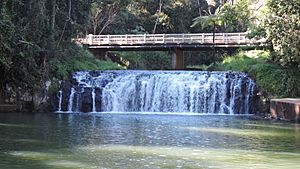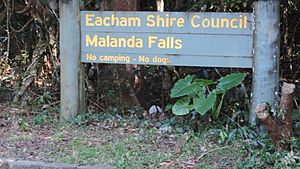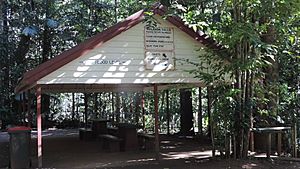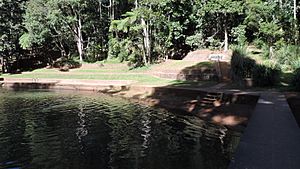Malanda Falls Swimming Pool facts for kids
Quick facts for kids Malanda Falls Swimming Pool |
|
|---|---|

Malanda Falls, 2016
|
|
| Location | Malanda Falls Park, Malanda, Tablelands Region, Queensland, Australia |
| Design period | 1900–1914 (early 20th century) |
| Built | 1906 onwards |
| Official name: Malanda Falls Swimming Pool | |
| Type | state heritage (built) |
| Designated | 5 February 2010 |
| Reference no. | 602733 |
| Significant period | 1906 onwards |
| Lua error in Module:Location_map at line 420: attempt to index field 'wikibase' (a nil value). | |
The Malanda Falls Swimming Pool is a special place in Malanda, Australia. It is listed on the Queensland Heritage Register because of its history. People started building it in 1906. You can find it in Malanda Falls Park, next to the beautiful Malanda Falls Conservation Park.
Contents
The Story of Malanda Falls Pool
The Malanda Falls Swimming Pool is on the North Johnstone River. It is part of the Malanda Falls Park. This area became a popular spot for locals in the early 1900s. Later, it grew into a big tourist attraction. It helped make the Cairns area a major holiday spot in Queensland.
Early Days and Local Fun
When settlers first came to the Atherton Tableland, they loved the waterfalls. They thought the waterfalls and jungles were beautiful. These natural spots were, and still are, very important for attracting visitors. Malanda Falls was always a favorite place for people living nearby. Over the years, it changed to fit the needs of the community. It also became more beautiful for tourists.
In 1906, the Falls area was surveyed. It had water lilies and jungle all around. In 1911, some equipment was installed to pump water. This water went to the Malanda Hotel and steam trains. The Falls stayed mostly natural until 1918. That year, local people cleared logs from the swimming area.
The Falls quickly became a popular place for New Year's Day picnics. By 1920, the local council built a diving platform. They also put up signs to keep things proper.
Growing as a Swimming Spot
In 1924, a fence was put up around part of the reserve. This might have been to stop animals from damaging the area. In 1925, a retaining wall was built. A narrow platform for swimmers was also added. That same year, Malanda's first swimming club started. Swimming competitions were held there until 1930. Clubs from Malanda, Atherton, Mareeba, and Cairns competed.
By 1934, the Malanda Swimming Club and the council had improved the pool. The council spent a good amount of money on it. More money was approved for improvements in 1934. The council also planned a path to the bottom of the Falls. This path included terraces and gardens.
How Tourists Discovered the Falls
Early tourism in the Cairns area used new transport systems. These systems were first built for mining and farming. The railway from Cairns to Mareeba helped places like Barron Falls become popular. Malanda Falls also benefited when the railway reached Malanda in 1910. A railway bridge was built over the Johnstone River. This made it easier for people to visit the Falls.
Later, the Gillies Highway was built in the 1920s. This road made the Falls accessible to even more people. Many tourists could now visit.
Car Tours and Holiday Fun
Pictures of Malanda Falls appeared in tourist books by 1920. By 1925, the Falls were part of a day trip. People would travel by car from places like Herberton or Ravenshoe. The trip also included visits to Lake Barrine, Lake Eacham, and Millaa Millaa Falls.
A local car service called Whitecars started around 1922. They offered tours to Malanda Falls. Some tours included other local sights. Whitecars helped tourism grow a lot on the Tablelands. In 1927, they won a contract to take passengers from Cairns. They also ran day tours from Yungaburra. By 1934, Whitecars had buses that could carry 17 passengers. Tourist guides at the time called the area "the land of waterfalls."
World War II and Post-War Growth
During World War II, many Australian and American soldiers were in the Atherton Tablelands. Malanda Falls was a favorite spot for swimming and picnics. Australian troops improved the pool during the war. They also built a three-level diving tower.
After the war, travel became easier. More people owned cars. New tours were created. Places like Malanda Falls became even more popular. In 1961, a caravan park was built next to the Falls. It had space for caravans, campsites, and cabins. Visitors to the park often went to the Falls.
In the 1960s, the facilities were updated. A new concrete diving platform was installed. There was also a steel climbing frame for swinging into the water. Grab rails and ladders were added for getting in and out of the pool. The Malanda Swimming Club also started up again.
Modern Traditions
Malanda Falls was featured in travel books until the 1970s. It is still a popular tourist spot today. The "Malanda Monsoon Festival" holds its welcoming ceremony at the Falls. The Ngadjon Jii people, who are the traditional owners, invite good spirits into the town. A Waterfall Ceremony is also held at dusk. Lanterns are lit beside the Johnstone River during this event.
What Malanda Falls Pool Looks Like
The Malanda Falls Swimming Pool is inside Malanda Falls Park. It is next to the Malanda Falls Conservation Park. You can find it on the edge of Malanda, along the Malanda-Atherton Road.
Rainforest trees line the road and the park entrance. Near the highway, there are picnic tables and barbecues. There is also a colorful mosaic that honors the local Aboriginal people. The Falls are very important to them. A large car park, a shelter shed, and toilets were built more recently.
The rainforest behind the Falls is beautiful. However, the river banks above the pool have been shaped and cleared. The western side of the pool is very organized. It has stone walls, neat lawns, concrete paths, fences, and steps with handrails. The stone walls are made of stacked rocks with concrete on top. The lower part has three extra concrete areas. Visitors often use these for seating.
The Malanda Falls Scenic Reserve includes the North Johnstone River. The river flows through thick rainforest. It then goes over the basalt rock of the Falls. The water drops about four meters. The Falls are about 30 meters wide. Below the Falls is a long, man-made swimming pool. Concrete paths surround the pool. These paths make it easy and safe to get into the water. They also let visitors cross the pool. On the western side, at the end of the path, there is a metal sign on the rock. It shows a diver in red.
A concrete bridge is at the north end of the pool. It is about 30 meters long. This bridge leads to more concrete paths. Behind these paths is a low stone wall. About halfway between the bridge and the Falls, there are pool steps. A metal handrail is attached to the concrete path there. On the north-eastern bank, steps with handrails lead to the Malanda Caravan Park. Further past these steps, you can see old concrete foundations and pipes. There are also parts of an old boiler. This boiler might have been used by the railway to pump water.
Why Malanda Falls Pool is Special
The Malanda Falls Swimming Pool was added to the Queensland Heritage Register on February 5, 2010. It met important standards to be listed.
Showing Queensland's History
The Malanda Falls Swimming Pool shows how tourism grew in North Queensland. It is a great example of how the region used its natural beauty to attract visitors. It started as a simple swimming hole for locals. Then, improvements like terraces and gardens changed it. It became a more organized recreation area and swimming pool. Since the 1930s, it has been a popular place for tourists.
Its Beautiful Look
The Malanda Falls Swimming Pool is loved for its beauty. It has been shown in tourist photos and books since the 1920s. It is known as a lovely spot that is part of Far North Queensland's waterfall and picnic trail. The well-kept swimming area is surrounded by terraced gardens and thick rainforest. Water flows over the basalt rock face into the pool below. This creates a very calm and peaceful feeling.




